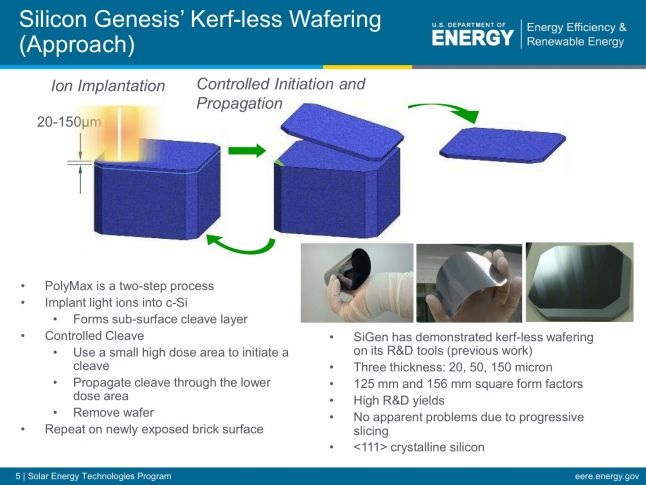It's an obvious weak link and cost target in the solar value chain: silicon is the major cost component in silicon solar panels. Manufacturers spend a great deal of time and energy to fabricate blocks of polysilicon, only to see up to half of that hard-earned material turned into sawdust in the wafer production step.
Silicon Genesis, known as SiGen, is just one of many startups pursuing novel ways of transforming blocks of silicon into thin solar wafers in a less wasteful -- and less expensive -- fashion.
Current wafer thickness is in the 150-micron range. Traditionally, wafers are freed from blocks of silicon using wire saws in a process that is "terribly messy, complex and reaching its limits," according to Adam Brailove, VP of Solar Equipment Engineering at SiGen. The wire saws use silicon carbide as an abrasive in the slurry and it's difficult to reclaim the lost materials from the resulting sawdust-SiC mix. There is a cost to the lost materials as well as the spent wires themselves. As manufacturers push the limit of wafer thickness, they are resorting to even more expensive methods like diamond wire saws.
SiGen promises kerf-free wafering via an implant-and-cleave process that is still in the early stages of development but could yield wafers with thicknesses down to 20 microns.
Their two-step process implants proton ions below the surface of a preshaped brick. A second step causes the silicon to crack off the layer. Brailove described it as "implant, cleave, implant, cleave." The firm is working with <111> silicon.
The proton energy determines how deep the protons go and therefore sets the thickness of the wafer. What the company terms "straggle" or variation in depth gets smaller as you move to lower energy levels (measured in MeV, Mega electron-Volts) and thinner wafers. Wafers that are 20 microns thick require 1.1 MeV.
The firm's prototype implant equipment in use today is in three stages -- an accelerator, a beamline and a vacuum end station. This is an enormous piece of equipment emitting protons and must be enclosed in a thick concrete-walled radiation vault to deal with gamma rays. The company claims high R&D yields and no apparent problems with the successive slicing. SEM and AFM microscopy are showing strong results with regards to surface roughness -- 10 to 20 times better than with a wire saw with a very tight wafer thickness distribution.
Brailove attributes this progress to "physics rather than a mechanical process."
Once the wafers are cleaved, there is an etch and anneal step to preserve lifetime.
Brailove spoke of collaboration with Georgia Tech and an unnamed PV cell manufacturer that has put the thin cells into their production line without incident. (Wild guess at unnamed PV manufacturer -- Suniva, because of the Georgia Tech connection. That's a wild guess with no confirmation.) SiGen has received DOE money and has partnered with REC.
SiGen is bringing a rather large piece of new disruptive equipment to the current established manufacturing flow. If the firm can show a cost and performance benefit, there is a chance for adoption. Rising silicon prices would help their cause as firms hustle to cut costs on the single biggest cost-driver in a photovoltaic panel.
The DOE's Steve Chu seems to like this type of process technology.
Other firms in the thin silicon business:
Ampulse claims that the firm’s "c-Si thin-film technology takes advantage of HW-CVD techniques to directly deposit a very thin layer of c-Si onto a uniquely textured and flexible metal substrate."
AstroWatt, as reported by Ed Gunther, has developed a Semiconductor on Metal technology for creating thin silicon wafers. Gunther reports, "After partial processing, a monocrystalline silicon wafer is attached to an inexpensive, flexible 50 um metal foil also acting as the solar cell’s rear contact. Next, the foil, along with about 25 um of silicon, is exfoliated using a cleaving process. By reusing a 600 um wafer for multiple exfoliations, AstroWatt claims “Up to 4X (four times) reduction in substrate cost” is possible, and the metal substrate is crucial for wafer handling in existing equipment. AstroWatt also stated the theoretical peak silicon solar cell efficiency can be achieved with a 25 um silicon wafer thickness."
Bangap Engineering has developed tunable methods for nano-structuring silicon. The firm claims that the absorption of nano-silicon is enhanced by up to several orders of magnitude over bare silicon over a wide range of wavelengths. This enables nano-silicon to absorb the light in the first four microns versus the top 50 to 100 microns that bulk silicon needs to absorb most of the light. This could impact cell efficiency and direct manufacturing cost -- and make for much thinner wafers.
Crystal Solar, recently profiled by Michael Kanellos, uses a vapor deposition process for making thin crystalline silicon wafers. The firm has made wafers measuring 50 microns thick in its labs and hopes to get down to 20 microns.
Twin Creeks Technologies is also working with ion implant, as per this patent.
1366 Technologies has a "direct wafer" technology where molten silicon is directly converted into wafers, which can then be processed into thin solar cells.
Others? Thin Silicon (looks more like a-Si), Clean Cell?
Developing a new wafer technology and integrating it into an existing process chain is an enormous challenge. Evergreen Solar tried to revolutionize wafer technology with its string ribbon technology, but size incompatibility with their odd-shaped wafers proved daunting and the firm is still feeling the echoes of that misstep today.
Greentech Media's upcoming Solar Summit explores every stage of the solar value chain. Join us in Palm Springs next month.



